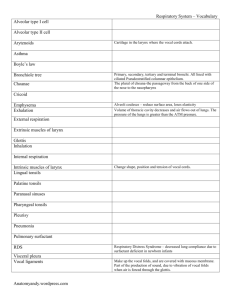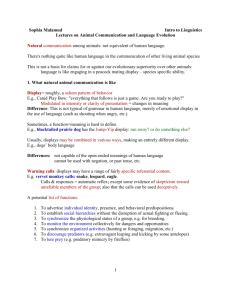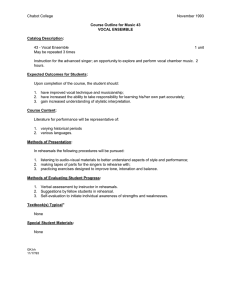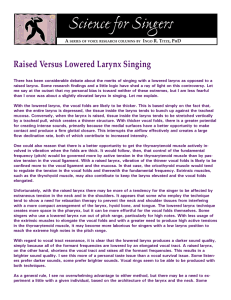Where are sounds produced?
advertisement
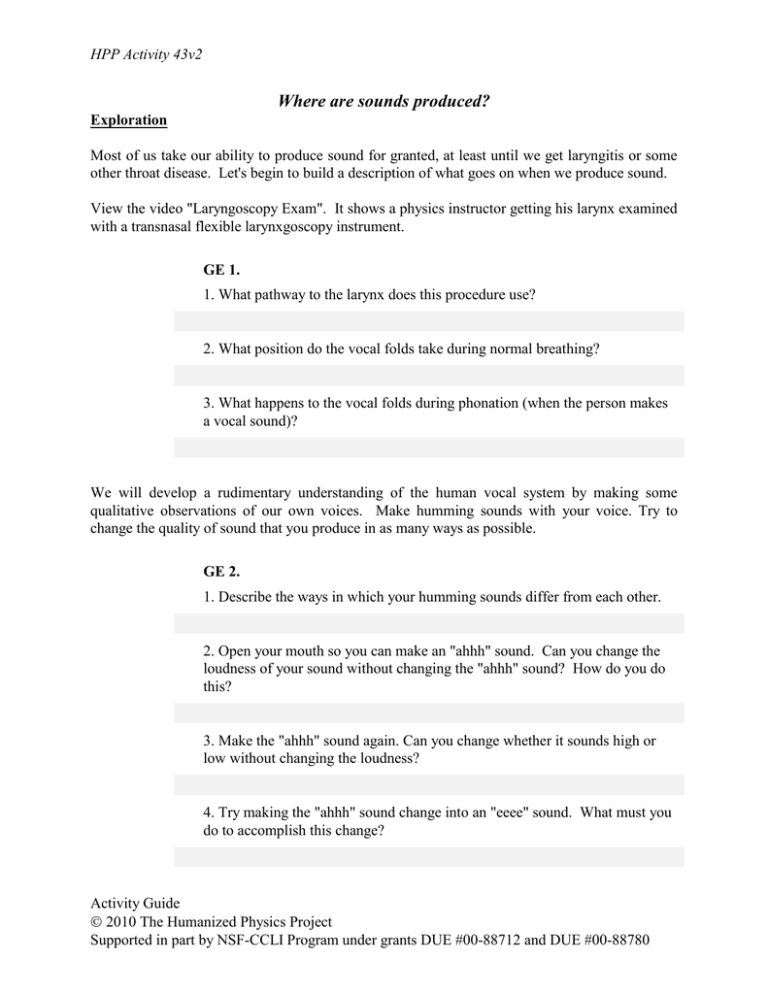
HPP Activity 43v2 Where are sounds produced? Exploration Most of us take our ability to produce sound for granted, at least until we get laryngitis or some other throat disease. Let's begin to build a description of what goes on when we produce sound. View the video "Laryngoscopy Exam". It shows a physics instructor getting his larynx examined with a transnasal flexible larynxgoscopy instrument. GE 1. 1. What pathway to the larynx does this procedure use? 2. What position do the vocal folds take during normal breathing? 3. What happens to the vocal folds during phonation (when the person makes a vocal sound)? We will develop a rudimentary understanding of the human vocal system by making some qualitative observations of our own voices. Make humming sounds with your voice. Try to change the quality of sound that you produce in as many ways as possible. GE 2. 1. Describe the ways in which your humming sounds differ from each other. 2. Open your mouth so you can make an "ahhh" sound. Can you change the loudness of your sound without changing the "ahhh" sound? How do you do this? 3. Make the "ahhh" sound again. Can you change whether it sounds high or low without changing the loudness? 4. Try making the "ahhh" sound change into an "eeee" sound. What must you do to accomplish this change? Activity Guide 2010 The Humanized Physics Project Supported in part by NSF-CCLI Program under grants DUE #00-88712 and DUE #00-88780 HPP Activity 43v2 Invention There are at least three important characteristics of our sound experience, whether it is speech or music. These characteristics include loudness, pitch, and timbre. The loudness characteristic is essentially self-explanatory: do you have to cover up your ears to remain comfortable listening to someone or do you have to ask them to speak up. Pitch refers to whether the sound is high or low. Timbre refers to whatever it is about the sound that enables us to distinguish between, let's say, an electric bass, and a tuba playing the same note; or what allows us to distinguish one person's voice from another, even when they are speaking in the same pitch range. Clearly, this is a complex characteristic. We must begin seeing our vocal tract produces how these experienced characteristics. Part of scientific investigation involves identifying the important system for whatever phenomenon is of interest. Here is a schematic picture of some parts of the vocal tract system. Adapted from Rossing, Moore, & Wheeler, The Science of Sound, 3rd Edition, Figure 15.1 (2002). Activity Guide 2010 The Humanized Physics Project 2 HPP Activity 43v2 3 The major parts of this system that seem to play a significant role in producing sound are the lungs, the larynx (which includes the vocal folds), the oral pharynx and cavity, mouth, the nasal pharynx and cavity. Application While the sound production system is too complex to make an exact, one-to-one correspondence between parts of the system and the different aspects of auditory experience, we can determine which parts do have a significant effect on each aspect of auditory experience. GE 3. 1. Think about how you varied the loudness of a humming sound. What part of the vocal tract system had the biggest effect on loudness? What observations lead you to your choice? 2. What part of the vocal tract system had the biggest effect on pitch? What observations lead you to your choice? 3. What part of the vocal tract system had the biggest effect on timbre? What observations lead you to your choice? Application We will construct a simple mechanical model of the larynx. First, observe a short video clip of the human larynx in action. It is the QuickTime file named normalVoice.mov. We will use a plastic tube for the trachea, a strip of latex cut down the middle for the vocal folds, and another plastic tube for the larynx cavity. Place the latex strips between the plastic tubes and attach the tubes together with rubber bands, as shown below. Activity Guide 2010 The Humanized Physics Project HPP Activity 43v2 4 The end of the larynx model representing the trachea should be attached to an air supply. GE 4. 1. Turn on the air supply. You may need to adjust the latex to achieve a sound. After getting a sound, try to vary the loudness. What must you do? 2. Can you vary the pitch of the sound produced? Describe how you do this. 3. How is the larynx model similar to the real human larynx? 4. How is the larynx model different from the real human larynx? Activity Guide 2010 The Humanized Physics Project

